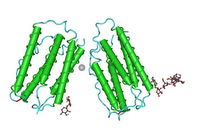interferons
Interferons are immune cytokines that are classified as type I, II, or III according to the receptors through which they signal. Interferon (INF) family receptors have conserved cysteine residues and include the receptors for IFN-α, IFN-β, and IFN-γ.
 ● IFN type I – bind to the IFN-α receptor (IFNAR) that consists of IFNAR1 and IFNAR2 chains – subtypes of IFN-α, IFN-β (image at left) , IFN-κ, IFN-δ, IFN-ε, IFN-τ, IFN-ω, IFN-ζ (limitin)
● IFN type I – bind to the IFN-α receptor (IFNAR) that consists of IFNAR1 and IFNAR2 chains – subtypes of IFN-α, IFN-β (image at left) , IFN-κ, IFN-δ, IFN-ε, IFN-τ, IFN-ω, IFN-ζ (limitin) 
● IFN type II – IFN-γ receptor (IFNGR) complex comprising two subunits each of molecules designated IFNGR1 and IFNGR2 – singel type IFN-γ (image at right)
● IFN type III –receptor complex comprising IL10R2 (CRF2-4) plus IFNLR1 (CRF2-12) – types IFN-λ1(IL29), IFN-λ2 (IL28A), IFN-λ3 (IL28B) (image)
Table Interferons
Cellular secretion of interferon is stimulated by:
● constituents such as CpG DNA from microbial pathogens – bacteria (endotoxin, flagellin, CpG) and viruses (viral glycoproteins, viral RNA, CpG)
● mitogens
● other cytokines, such as the interleukins (1, 2, 12), TNFs, and colony-stimulating factors
Interferon actions:
● anti-tumor
● antiviral
● activation of macrophages and NK cells
● presentation of microbial peptides to T cells through enhancement of MHC classes I and II
Fc receptors Immune Cytokines Immunoglobulins Interferons

 ● IFN type I – bind to the IFN-α receptor (IFNAR) that consists of IFNAR1 and IFNAR2 chains – subtypes of IFN-α, IFN-β (image at left) , IFN-κ, IFN-δ, IFN-ε, IFN-τ, IFN-ω, IFN-ζ (limitin)
● IFN type I – bind to the IFN-α receptor (IFNAR) that consists of IFNAR1 and IFNAR2 chains – subtypes of IFN-α, IFN-β (image at left) , IFN-κ, IFN-δ, IFN-ε, IFN-τ, IFN-ω, IFN-ζ (limitin) 
● IFN type II – IFN-γ receptor (IFNGR) complex comprising two subunits each of molecules designated IFNGR1 and IFNGR2 – singel type IFN-γ (image at right)
● IFN type III –receptor complex comprising IL10R2 (CRF2-4) plus IFNLR1 (CRF2-12) – types IFN-λ1(IL29), IFN-λ2 (IL28A), IFN-λ3 (IL28B) (image)
Table Interferons
Cellular secretion of interferon is stimulated by:
● constituents such as CpG DNA from microbial pathogens – bacteria (endotoxin, flagellin, CpG) and viruses (viral glycoproteins, viral RNA, CpG)
● mitogens
● other cytokines, such as the interleukins (1, 2, 12), TNFs, and colony-stimulating factors
Interferon actions:
● anti-tumor
● antiviral
● activation of macrophages and NK cells
● presentation of microbial peptides to T cells through enhancement of MHC classes I and II
Fc receptors Immune Cytokines Immunoglobulins Interferons
Labels: cytokines, immune response, inflammation, interferon







































